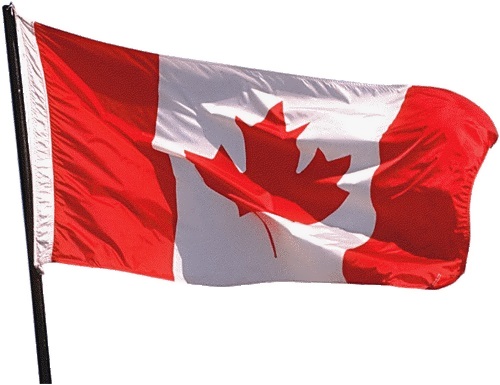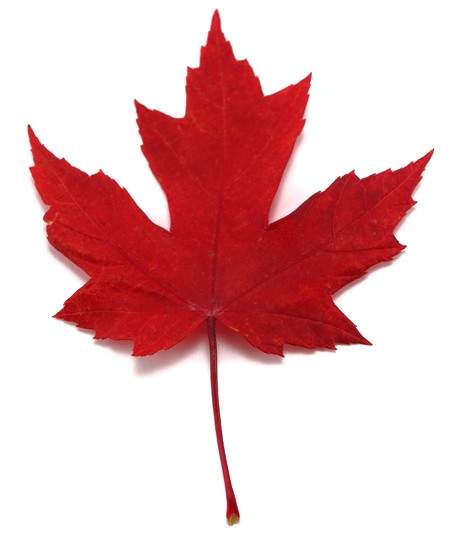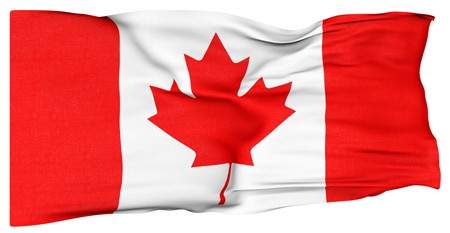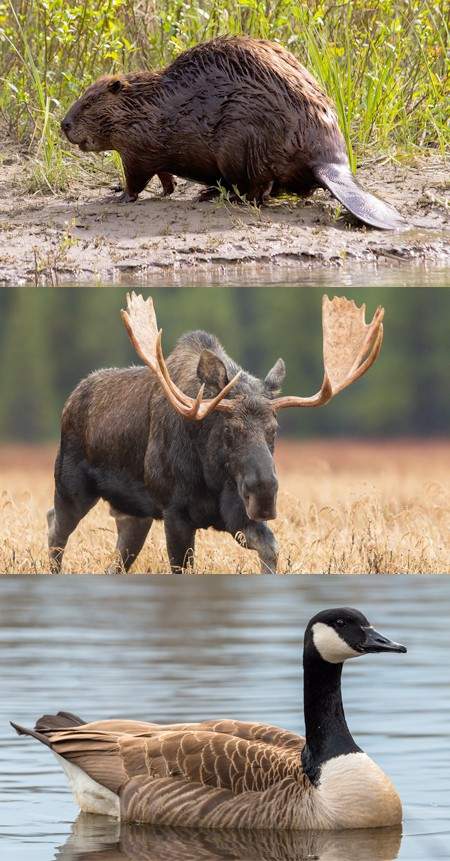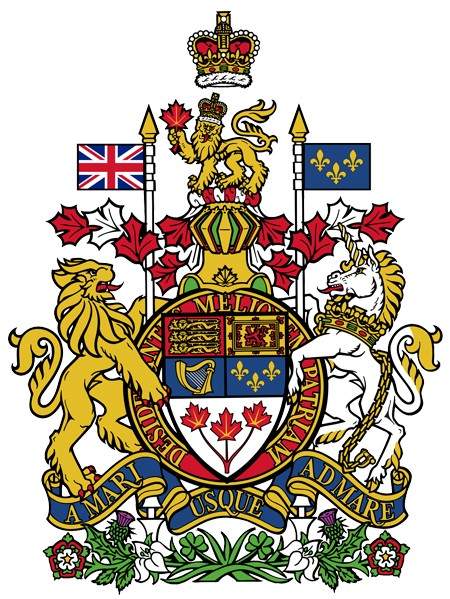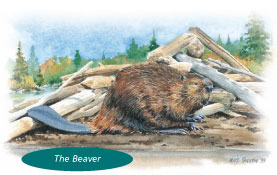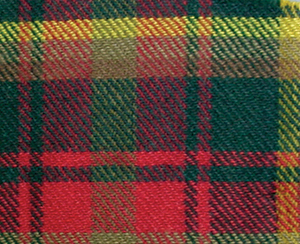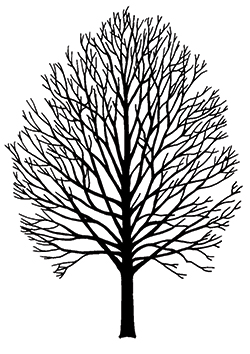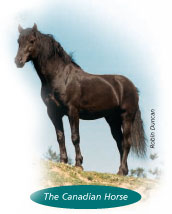What is the emblem of canada
What is the emblem of canada
Symbols of Canada

Canada is a North American country consisting of ten provinces and three territories. Located in the northern part of the continent, it extends from the Atlantic to the Pacific and northward into the Arctic Ocean. Canada is the world’s second-largest country by total area, and its common border with the United States is the world’s longest land border.
The National symbols of Canada represent all that the nation stands for, its people, places, traditions and cultures. For every citizen of Canada, the National symbols offer a sense of pride and honor in being a part of such a beautiful and diverse nation. The various National symbols of Canada are:
• The National flag
• The National anthem
• The Coat of Arms
• The Maple leaf
• The National animal 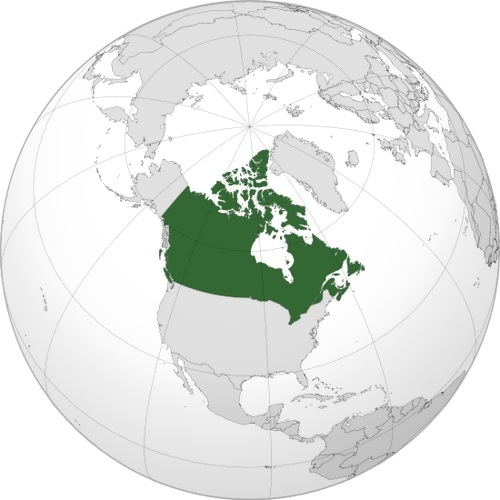
National Flag
The National flag of Canada was officially adopted and inaugurated in the year 1965 after several years of political debate over the flag’s design. The National flag holds a special place of honor as one of the foremost national symbol of Canada and therefore treated with much reverence.
Canada’s official National flag is colored red and white, the country’s official colors, and its center bears a maple leaf which is Canada’s traditional emblem.
National anthem
“O Canada” was officially declared the National anthem of Canada on 1st July, 1980, a century after it was first sung in 1880. The original lyrics of the anthem were written in French by Sir Adolphe-Basile Routhier and the music was composed by Calixa Lavallee. Over the subsequent years, several English versions of the anthem were also created. The official English version of the anthem was written by Mr. Justice Robert Stanley Weir.
As a National symbol of the country, “O Canada” is sung at sporting events, school assemblies and other formal occasions of national importance.
Official Lyrics of O Canada!
Lyrics O Canada (English version)
O Canada!
Our home and native land!
True patriot love in all thy sons command.
With glowing hearts we see thee rise,
The True North strong and free!
From far and wide,
O Canada, we stand on guard for thee.
God keep our land glorious and free!
O Canada, we stand on guard for thee.
O Canada, we stand on guard for thee.
Lyrics O Canada (French version)
« O Canada! Terre de nos aueux,
Ton front est ceint de fleurons glorieux!
Car ton bras sait porter l’epee,
Il sait porter la croix!
Ton histoire est une epopee
Des plus brillants exploits.
Et ta valeur, de foi tremp?e,
Protegera nos foyers et nos droits.
Protegera nos foyers et nos droits. »
Lyrics O Canada (Bilingual version — non official)
O Canada! Our home and native land!
True patriot love in all thy sons command,
Car ton bras sait porter l’epee,
Il sait porter la croix!
Ton histoire est une epopee
Des plus brillants exploits,
God keep our land glorious and free!
O Canada, we stand on guard for thee.
O Canada, we stand on guard for thee.
National Motto: A Mari Usque Ad Mare (From sea to sea)
National colors: Red and White 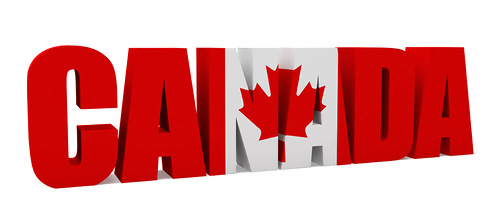
History records that in the First Crusade Bohemund I, a Norman lord, had red crosses cut from his mantles and distributed to the 10,000 crusaders, who wore them as a distinctive badge on their garments.
In subsequent crusades, each nation was distinguished by a cross of a different colour. France long had a red cross on its banners while England used a white cross. In the course of history, red and white alternated as the national colours of France and England.
Red and white were approved as Canada’s official colours in the proclamation of her coat of arms in 1921.
In 1957, the colour of the maple leaves on the shield of the Royal Arms of Canada was changed from green on a white ground to red on a white ground in recognition of Canada’s official colours.
The Maple leaf 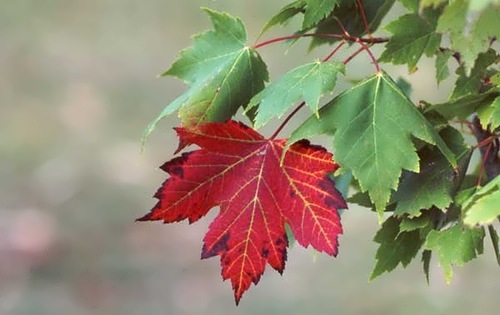
The history of the maple leaf as a symbol of Canada can be traced back as early as 1700. As Canada’s National emblem, the maple leaf appears on the national flag and coins and for many years it was used as a symbol of the Canadian Armed Forces. The maple leaf attained official status subsequent to the adoption of the new National flag of Canada which bears the leaf in its center.
Well before the coming of the first European settlers, Canada’s aboriginal peoples had discovered the food properties of maple sap, which they gathered every spring.
In 1834, the St. Jean Baptiste Society made the maple leaf its emblem.
In 1836, Le Canadien, a newspaper published in Lower Canada, referred to it as a suitable emblem for Canada.
In 1848, the Toronto literary annual The Maple Leaf referred to it as the chosen emblem of Canada.
Alexander Muir wrote The Maple Leaf Forever as Canada’s confederation song in 1867; it was regarded as the national song for several decades. The coats of arms created the next year for Ontario and Quebec both included the maple leaf.
The maple leaf today appears on the penny. However, between 1876 and 1901, it appeared on all Canadian coins. The modern one-cent piece has two maple leaves on a common twig, a design that has gone almost unchanged since 1937.
In 1957, the colour of the maple leaves on the arms of Canada was changed from green to red, one of Canada’s official colours.
On February 15, 1965, the red maple leaf flag was inaugurated as the National Flag of Canada.
Maple trees have played a meaningful role in the historical development of Canada and continue to be of commercial, environmental and aesthetic importance to all Canadians. Maples contribute valuable wood products, sustain the maple sugar industry and help to beautify the landscape. Maple wood, which varies in hardness, toughness and other properties, is in demand for flooring, furniture, interior woodwork, veneer, small woodenware, and supports several flourishing industries in eastern Canada. Maple is also highly prized in furniture building and cabinet-making.
The maple tree was officially proclaimed national arboreal emblem of Canada on April 25, 1996. It was published in the Canada Gazette on May 15, 1996. 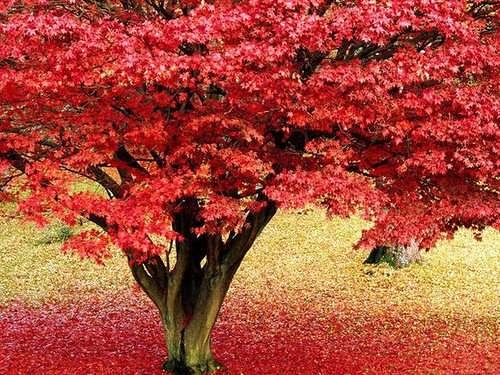
National animal
Canada has two national animals – the beaver and the Canadian Horse. 
The Beaver associated with the discovery of the country itself. As an official National symbol, the beaver appears on several Canadian memorabilia like stamps and coins. The beaver is a symbol of ingenuity and perseverance. The beaver officially became the emblem of Canada on 24 March, 1975. Beaver is more popular than Bieber))) 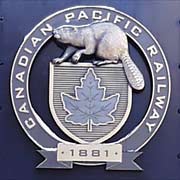
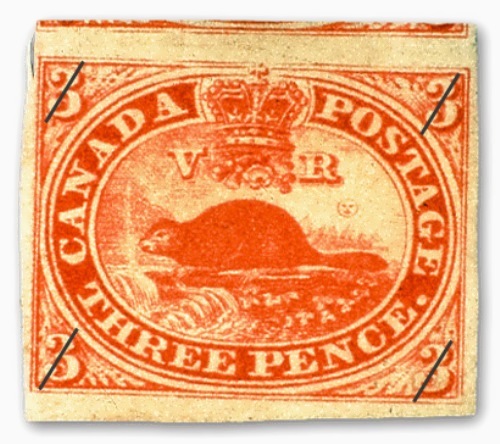
The Canadian Horse is another animal commonly seen as a national symbol of Canada. The government of Canada passed a bill in 2003, which made the Canadian Horse an official symbol and a national animal of Canada. This animal is associated with the agricultural traditions and historical origins of the province of Quebec, and hence, provincial legislation recognized the Canadian Horse as a ‘heritage breed of Quebec’. 
The origin of the name «Canada» comes from the expedition of explorer Jacques Cartier up the St. Lawrence River in 1535. The Iroquois pointing out the route to the village of Stadacona, the future site of Quebec City, used the word «kanata,» the Huron-Iroquois word for village. Jacques Cartier used the word Canada to refer to both the settlement of Stadacona and the land surrounding it subject to Chief Donnacona.
By 1547, maps were showing the name Canada applied to everything north of the St. Lawrence River. The St. Lawrence River was called the «rivi?re du Canada» by Cartier.
Canada wasn’t the only name. Other names suggested at the time of Confederation were: Victorialand, Borealia, Cabotia, Tuponia (The United Provinces of North America), Superior, Norland, Hochelaga. 
source
Emblems of Canada
| Published Online | October 4, 2011 |
| Last Edited | March 4, 2015 |
Emblems of Canada include the national coat of arms and flag. When John Cabot arrived on the shores of North America in 1497, he raised a cross and the royal banner of England. Since then, Canada’s emblems have evolved out of those traditionally used by France and Britain. Today they include such national symbols as the beaver and the maple leaf.
When John Cabot (Giovanni Caboto) landed on the coast of North America on St John the Baptist Day, 24 June 1497, he formally took possession of the surrounding territory in the name of King Henry VII of England by raising a large cross and the royal banner, which then contained the three gold fleurs-de-lis of France on a blue field and the three gold lions of England on red, both repeated twice. Beginning in 1340, the fleurs-de-lis occupied the most important quarters of both the royal banner and arms (i.e., coat of arms) to express England’s claim to the throne of France.
The British continued to display the royal arms at land claims, such as Sir Humphrey Gilbert’s ceremony claiming Newfoundland in 1583. They adorned the seals used in the Canadian colonies and the medals awarded to Aboriginal chiefs by British sovereigns. Some examples of the royal arms have survived in courthouses, post offices and Anglican churches.
Like the British use of their arms, the royal arms of France (three gold fleurs-de-lis on blue) were consistently displayed at land claiming ceremonies beginning with Jacques Cartier in 1534. In New France, they were exhibited on city gates, forts and important buildings, including churches and public places. They also appeared on government seals and coins.
At Confederation in 1867 no arms were assigned to the new Dominion of Canada. In 1868 the original provinces — Nova Scotia, New Brunswick, Québec and Ontario — received arms by a royal warrant that also provided for a great seal of Canada, a shield bearing the arms of the four provinces. On the great seal assigned to Canada in 1869, the arms of each province appeared separately, two on each side of the figure of Queen Victoria. The four province shield survived and came to be considered the arms of the Dominion.
As additional provinces entered Confederation, armorial bearings assigned to them were added to the federal shield, creating an unsatisfactory aggregation. A Canadian committee appointed in 1919 decided within a year on the basic elements of a new design, which was forwarded to the College of Arms in London, England, for its consideration. In 1921 King George V, by royal proclamation, assigned armorial bearings for Canada.
The design is traditional, with the shield displaying the arms of England, Scotland, Ireland and France to symbolize the nation’s founders. Underneath the four quarters, on a white field, is a sprig of three maple leaves to indicate the new nation of many peoples. Originally green, in 1957 the leaves officially became red, a common autumnal colour, and thus in accord with Canada’s national colours, red and white. The crest and the shield’s supporters are strikingly similar to the royal arms of Great Britain. The motto A Mari Usque ad Mare («From sea to sea») is from the Bible’s Psalm 72:8: «He shall have dominion also from sea to sea, and from the river unto the ends of the earth» (King James Version). In 1994 a ribbon with the motto of the Order of Canada, Desiderantes meliorem patriam («They desire a better country»), was added to the arms of Canada.
Flags
The red and white flag featuring a stylized maple leaf was proclaimed Canada’s national flag by Queen Elizabeth II in 1965. Its adoption was the culmination of many years of discussion, hundreds of designs and the heated flag debate in Parliament. The proportions of the flag are in a ratio of two to one: two by length and one by width. The white square in the centre is called a “Canadian pale” because it is twice as wide as the usual pale, a heraldic term meaning a vertical band.
Before 1965 Canada did not have an official flag. During the French regime the royal banner of France — three gold fleurs-de-lis on a blue field — was flown briefly during the early years of colonization in Canada and the failed colony in Florida in 1564–65. In the first half of the 17th century, Canadians became convinced that the completely white flag of the French Royal Navy, which they saw on ships and forts, was in fact the national flag of France, the flag they owed allegiance to. After the Conquest in 1760 the flags most commonly flown were Great Britain’s Union Flag (Union Jack) and the Canadian Red Ensign. The latter was the flag of the British merchant marine, red, with the Union Jack in the canton (i.e., upper portion near the staff). From its forts and canoes, the Hudson’s Bay Company, which governed a large part of what is now Canada, flew the Red Ensign with HBC in the fly (i.e., the portion furthest from the staff). Soon after Confederation, Canadians began flying, on both land and sea, the Red Ensign with the shield of the Dominion in the fly. As the number of arms increased, the shield was difficult to recognize, especially at sea. In 1892, the British Admiralty authorized its use, with the addition of the original four province shield in the fly, on merchant vessels registered in Canada. In 1912, the British secretary of state instructed the governor general that the Union Flag was Canada’s flag to be flown on land.
In 1924, a Canadian order-in-council decreed that the Red Ensign with the shield of Canada in the fly could be flown over Canadian government buildings abroad. The Red Ensign was later carried by Canadian athletes at the Olympics and by Canadian troops in the Second World War. In 1945, another order-in-council approved the flying of the flag over federal buildings within Canada. To many Canadians the Red Ensign was the national flag, and this led to intense feeling when Parliament proposed to replace it with a new design.
Beaver
The beaver, most significant of the fur-bearing animals sought in the fur trade, was identified early as an emblem suitable to represent portions of the vast territories that in the 19th century became Canada. In 1621, King James I granted Nova Scotia to Sir William Alexander. In 1633, when Alexander became Earl of Stirling and Viscount Canada, his new arms featured a beaver to symbolize his fiefdom in the New World.
From 1678 the Hudson’s Bay Company (chartered 1670) possessed an armorial seal charged with four beavers and separated into compartments formed by a St George’s cross. In 1673, Governor Frontenac proposed arms for Québec City. The arms were not authorized, but the fact that his proposal combined the fleurs-de-lis of royal France with the beaver on the same shield is a clear indication that he viewed the beaver as a major Canadian symbol. In 1690, to commemorate Frontenac’s successful defence of the Québec Citadel against the naval attack by Sir William Phips, the Kebeca Liberata (“Québec delivered”) medal was struck. It bore a representation of France as a seated woman and of Canada as a beaver at her feet. A medal entitled “Upper Canada Preserved” was struck during the War of 1812. It shows the British lion protecting the Canadian beaver against the American eagle on the other side of the Niagara River.
The use of the beaver as a Canadian emblem declined in the second half of the 19th century, while the maple leaf’s popularity increased. The animal’s emblematic importance was revived by Sir Sandford Fleming when he designed Canada’s first postage stamp, the 1851 three-penny beaver. Today the beaver, noted for its industry, skill and perseverance, qualities considered suitable for a nation to emulate, decorates the reverse of the Canadian five-cent coin. The beaver was made an emblem of the country by Parliament in 1975.
Maple Leaf
No evidence exists that the maple leaf was viewed as a Canadian emblem before the early 19th century. The first known written mention of the maple as an emblem of Francophone Canadians was within an epigram in a 29 November 1806 issue of Le Canadien addressed to its rival English newspaper, the Mercury. The maple accuses the thorny rose (symbol of England) of maliciously tearing at passers-by. In 1807, or some years before, the Montréal silversmith Robert Cruickshank produced a medal where the central shield of the royal arms of Great Britain is replaced by a single maple leaf, a strong statement that the leaf was also a symbol of Anglophone Canadians. At the 1836 banquet of the St-Jean-Baptiste Society, a speech by the president,Denis-Benjamin Viger, contained a clear statement that the maple tree was the emblem of Francophone Canadians, and the same idea was repeated in a song. The 14 November 1836 issue of Le Canadien declared that the maple leaf was the emblem of Lower Canada; and, during the Rebellion of 1837, both the Lower and Upper Canada Patriots displayed the leaf to express Canadian identity.
When describing his visit to Québec City in 1847, Lord Elgin wrote that the president of the St-Jean-Baptiste Society wore «the maple leaf, the Canadian French Emblem.” But already the maple leaf had become an emblem of the two Canadas. Joseph Maffré’s The Original Canadian Quadrilles, published that same year, displays on its cover a beaver enclosed in maple branches. In Toronto the 1848 issue of Reverend John McCaul’s literary annual, Maple Leaf, referred to the leaf as “the chosen emblem of Canada.”
The maple leaf was officially recognized for the first time as a Canadian symbol in 1859 when the Prince of Wales presented the 100th Regiment (Royal Canadians) with its colours in England. A maple leaf was present at each corner of the regimental flag. The next year the regiment incorporated branches of maple into its badge, and that year the leaves were used extensively in decorations for the Prince of Wales’s visit. In 1867 Alexander Muir composed «The Maple Leaf Forever,» a song which for decades was regarded as a national hymn. The designs of arms granted to Québec and Ontario in 1868 each incorporated a sprig of three maple leaves. The maple leaf was the badge of the Canadian Expeditionary Force in the First World War. When national armorial bearings were assigned in 1921, a sprig of leaves was an important feature, and in 1965 the maple leaf became the dominant element in the new national flag.
In 2011, the Canadian government selected the Maple Leaf tartan to be Canada’s national tartan. The tartan design, featuring a distinctive green and red pattern suggesting the shifting hues of autumn leaves, was designed in 1964 by Toronto garment maker David Weiser as part of the lead-up to Canada’s centennial celebrations. In a statement issued by Heritage Minister James Moore, «The Maple Leaf Tartan has been worn proudly and enjoyed by Canadians for decades, but has never been elevated to the level of an official symbol – until now. Our national symbols express our identity and define our history. The Maple Leaf Tartan represents the contributions that the more than four million Canadians of Scottish heritage continue to make to our country.»
Canadian Symbols (A List with Images)
Table of Contents
Like all nations, Canada, located in a part of North America, recognizes a number of important symbols to present itself both as a country and a nation. Some symbols are quite unique and well-known whereas others are less ubiquitous.
While there are hundreds of Canadian symbols, here’s a quick look at a few of the most famous official and non-official Canadian emblems that are well-known throughout the world. Over the past years, several of these symbols were formally adopted by the Canadian Government and have been declared official symbols of Canada.
The Canadian National Flag
The Canadian National Flag, also known as the Maple Leaf Flag, is composed of a white square in the middle of a red field with a stylized maple leaf at its center. It’s the present flag of the country which was approved in 1965 after months of debate on the design.
There’s a lot of symbolism in both the colors and the design of the Canadian flag.
While there aren’t any official laws on the usage of the national flag, Canadian Heritage brought forth a set of guidelines on how to display it, whether on its own or among other flags.
The Canadian Coat of Arms
Canada has one of the most elaborate coat of arms composed of many elements. Here’s what they stand for:
The Canadian Crown
The Royal Crown of Canada has been a national symbol of the state for about 400 years, representing the government, legislatures, Parliament, police services, courts and the forces. Canada, since Confederation in 1867 during the reign of Queen Victoria, has been a constitutional monarchy represented by the Royal Crown.
Poutine
Poutine is a Canadian dish including cheese curds and French fries topped with a thick, brown, chicken gravy. The dish originated in the province of Quebec and made its first appearance in rural snack bars in the area. It was mocked and perceived negatively for many years but over time it gradually became a quintessential symbolic of Quebecois culture. In fact, people refer to it as ‘Quebec in a bowl’.
Today, Poutine is no longer mocked and is typically presented as the national dish of Canada, symbolizing the country’s cuisine and culture. It’s a favorite among many people and can be found even in famous fast food chains like Burger King and McDonalds.
The Beaver
The beaver was a major part of Canadian identity long before it was given the official status as the national emblem in 1975. In the 1600s and 1700s, the main profit-making attraction in the country were beavers and during this time, there was a popular demand for fur hats which required beaver pelts. As the demand for hats increased, so did the demand for pelts and this trade proved to be so profitable that the Canadians felt that it was necessary to pay tribute to the animal.
The beaver was included in the Canadian Coat of Arms and even a coin, known as a ‘buck’, was created with its value equal to that one of a single male beaver pelt. Today, the beaver is one of the most important and revered official symbols in the country without which it’s said that Canada would not even exist.
The Maple Leaf Tartan
Designed by David Weiser in 1964 to commemorate the new flag of Canada, the Maple Leaf Tartan is now one of the official national emblems of the country as of 2011. The tartan has four colors on it which symbolize the life cycle of the maple leaf as it goes through the seasons. The color of the leaf changes from green in the spring to gold in early autumn, to red at the start of winter and finally to brown after it has fallen.
Canadians have worn the Maple Leaf Tartan proudly for decades before it was named a national symbol. It’s one of the most visual expressions of Scottish culture and heritage and being an official symbol highlights the significant contributions that the Scottish made towards the founding of Canada.
The Maple Leaf and Tree
There are over 100 different species of maple trees around the world, out of which 10 are native to Canada. The maple leaf is very closely associated with Canada and is featured on the national flag, but the tree itself wasn’t officially recognized as the country’s official arboreal emblem until 1996.
The maple leaf has been a staple of the Canadian people for decades and its sap was used for food as well as other necessities. Every spring, the leaves were gathered and became an important part of various culinary recipes. Now, it symbolizes endurance and strength and is a crucial element of the Canadian flag. It one of the most widely recognized national symbols of Canada and was added to the Canadian coat of arms in 1921.
The Canadian Horse
In 1902, the Canadian horse was declared by the Parliament as Canada’s national breed, but it was only in May of 2002 that it became recognized as the national horse of Canada. The origins of the horse go all the way back to 1665 when the King of France sent many horses from his royal stables to New France.
The Breton and Norman horses were mixed in origin, including Barb, Arabian and Andalusian horses and over the period of a century, the population of horses in New France continued to develop in isolation from other horse breeds. The result was a new breed – the Canadian horse, known for its strength and endurance, intelligence, good temper and resilience.
The Canadian horse was in danger of becoming extinct in the 19 th century and efforts were made throughout the late 1800s and the 20 th century to preserve this distinctive animal.
The Turtle
The turtle is a highly significant symbol in the Indigenous Canadian culture. According to certain First Nations stories (stories told by the indigenous people in Canada) it’s said to be the foundation on which the land was built. In some versions of the Earth Diver myth, it’s stated that the Earth was formed on a turtle’s back and became known as ‘Turtle Island’, the name given to North America today.
Turtles are associated with stability and longevity in Canadian culture and they’re also seen as easy-going, wise and patient creatures. There are about 12 different species of turtles all over Canada which are currently under the threat of extinction and being protected by the Nature Conservancy of Canada.
The Enchanted Owl
The Enchanted Owl is a painting created by Kenojuak Ashevak, the first Inuit woman to have her artwork on a Canadian postage stamp in the year 1960. This was a time when Inuit art was becoming extremely popular in Canada.
The painting depicts a stylized arctic owl with long feathers and a spotted body. The shape of the owl’s feathers, the detail on its body and the emotion in its eyes are all highly expressive and always capture viewers. This painting became popular across the country and is now a well-known Canadian icon that’s been reproduced in many publications and featured on the six-cent postage stamp to commemorate the 100 th anniversary of the Northwest Territories.
Ice Hockey
Canada has two national sports – ice hockey in winter and lacrosse in summer. Of the two, however, ice hockey is the sport for which Canada is best known for and is often considered Canada’s greatest contribution to global sports. This is because ice hockey originated in Canada and the game is viewed by Canadians as theirs. Ice hockey remains Canada’s most watched, played and successful sport.
In Brief
Many of the Canadian symbols we’ve mentioned in this article are famous worldwide and commonly seen in different contexts. Some of them, like the Enchanted Owl, are being reproduced every day in publications, on stamps, coins or in the fashion world. They truly represent what it is to be Canadian and, together they highlight the culture, heritage, values and resources of the Canadian people.
Canadian Icons and Emblems
Every country has a set of patriotic icons that citizens use to celebrate the uniqueness of their homeland, and Canada is no exception. Canada’s national emblems run the gamut from historic and dignified to modern and corny, but rare is the Canadian who doesn’t feel at least a little twinge of pride towards them.
Sugar Maple
Though there are over 10 different types of maple trees in Canada, each with slightly differently-shaped leaves, the most famous species is the sugar maple (Acer saccharum), whose leaf is on the Canadian flag. Though sugar maple leaves are normally green, they turn bright red in the autumn.
The Maple Leaf
The distinctively-shaped maple leaf is the most common catch-all symbol for Canada, appearing not only on the Canadian national flag (see below), but virtually every logo of a Canadian corporation or charity, or any other organization that needs to make its “Canadianness” instantly known.
The maple leaf is a symbol that’s been so famous for so long that no one seems to remember exactly where it came from or how it got to be so popular. Various species of maple trees (of the plant family Aceraceae ) can be found in most regions of Canada, and their multipurpose functionality as both a provider of lumber and edible, sweet syrup has proved useful to many generations of Canadians over the centuries. In one sense, the maple can be viewed as a tree that rewards labour and perseverance, and evokes the history of early Canadians able to “tame” the wilderness for their own benefit. But to many others, it’s simply a pretty tree with a pretty leaf that has become associated with Canada — and that’s good enough.
Flags Everywhere
When it’s not flying from a pole, the Canadian flag can be seen on t-shirts, baseball caps, bumper stickers, pencil cases, ice cream cakes, tattoos, and virtually anything else you can imagine. As you might expect, there aren’t a lot of taboos in Canada about inappropriate places to put the flag.
The Canadian Flag
Like every other country on earth, Canada has a national flag suitable for flying, hanging or waving in any circumstance where a bit of patriotic pride is needed. Adopted in 1965, the official flag of Canada is known as the Maple Leaf, and consists of a stylized red leaf on a white background bordered by two red bars on either side. Unusually for a national flag, no part of the design is supposed to represent anything in particular; the stylized leaf was simply created as a neutral symbol of Canadian unity, and there is no official explanation of what the colours or bars are supposed to mean.
Every province in Canada has its own flag as well, as do many cities. The history and evolution of Canadian flags is a fairly large and interesting topic in its own right, so for more information, please check out the Canadian flags chapter.
A beaver, a moose, and a Canada goose, all in their natural Canadian habitats.
Canadian Animals
The wilderness itself may be Canada’s most iconic symbol. As an enormous country with more untouched nature than any other, it’s unsurprising a vast assortment of things associated with the great outdoors feature so prominently in the Canadian gallery of national symbols. As the original residents of nature, Canada’s diverse array of wild animals are among its most famous representatives.
The beaver (Castor canadensis) is the most famous Canadian animal. It appears on the Canadian nickel and is often used by cartoonists to personify the country as a whole, much like “Uncle Sam” or a Chinese dragon. Though today beavers are often celebrated for their plucky, hardworking character, chomping down trees to build elaborate live-in dams, the original Canadian attraction to beavers was much less respectful: they had good fur for making hats. Prized for its smooth, waterproof texture, beaver fur was one of Canada’s main exports to Europe during the 17th and 18th centuries. So much so, in fact, that the animal was almost hunted to extinction by early Canadian fur traders. Saved by changing tastes in fashion, today they can be found lurking in riverbeds all across the country.
Less rich in specific symbolism are some of the beaver’s furry pals, such as the moose, the polar bear, the black bear, the mountain lion, the mountain goat, the elk, the Arctic wolf, the raccoon, the lynx and the bison, all of which are common sights not only in the Canadian wilderness, but also Canadian airport gift shops. And then there are the birds, including the loon (Gavia immer) — the national bird of Canada and namesake of the loonie — and the not-quite-so beloved Canada goose (Branta canadensis), an elegant-looking animal that is nevertheless quite ornery and unpleasant in its interactions with humans. Every province has its own official bird as well, the most famous of which are probably the snowy owl of Quebec and the puffin of Prince Edward Island.
The Coat of Arms of Canada was officially adopted in 1921, and in its initial form it was virtually identical to Britain’s Royal Coat of Arms. In 1994 it was modified slightly to include Canada’s second motto («Desiderantes Meliorem Patriam,» see below) as well as some red and white maple leafs at the top.
The Canadian Coat of Arms
Like most countries of European heritage, Canada has a grandiose heraldic symbol known as the Coat of Arms (also known as the national crest) that appears on things like passports, government publications and wax seals. It’s a very complicated and detailed illustration that is almost entirely identical to Britain’s Royal Coat of Arms, which dates back to the 17th century.
The crest’s symbolism is largely British: it depicts an English lion and a Scottish unicorn holding a shield displaying medieval icons of the English, Scottish, and Irish peoples of the British Isles, plus the fleur-de-lis of the French and the maple leaves of Canada. At the creatures’ feet sit a medley of plants representing the Scottish, Irish, English, and Welsh. The animals stand below the flags of the United Kingdom and medieval France, symbolizing the “two founding nations” of modern Canada.
Canada has two national mottoes, both of which are inscribed in Latin on the crest. The first (on the red belt around the shield) is Desiderantes Meliorem Patriam, or “They Desire a Better Country,” which acknowledges the immigrants who have built Canada and Canadians’ ongoing desire for national self-improvement. The other (on the blue ribbon at the bottom) is A Mari usque ad Mare, or “From Sea to Sea,” which celebrates the country’s vast geography.
Official symbols of Canada
Over the past century, the following symbols have been formally adopted by the Government of Canada and are now considered official symbols of our country.
The beaver
The beaver was given official status as an emblem of Canada when “An Act to provide for the recognition of the Beaver ( Castor canadensis ) as a symbol of the sovereignty of Canada” received royal assent on March 24, 1975. However, the beaver was a part of the Canadian identity long before Parliament passed the National Symbol of Canada Act.
Historical significance of the beaver
After the early European explorers realized Canada was not the spice-rich Orient, the main profit-making attraction was the beaver population. In the late 1600s and early 1700s, the fashion of the day demanded fur hats, which needed beaver pelts. As these hats became more popular, the demand for the pelts grew.
King Henry IV of France saw the fur trade as an opportunity to acquire much-needed revenue and to establish a North American empire. Both English and French fur traders were soon selling beaver pelts in Europe at 20 times their original purchase price.
The trade of beaver pelts proved so profitable that many Canadians felt compelled to pay tribute to the buck-toothed animal.
Despite this recognition, the beaver was close to extinction by the mid-19th century. There were an estimated six million beavers in Canada before the start of the fur trade. During its peak, 100,000 pelts were being shipped to Europe each year; the Canadian beaver was in danger of being wiped out. Luckily, about that time, Europeans took a liking to silk hats and the demand for beaver pelts all but disappeared.
Today, thanks to conservation and silk hats, the beaver – the largest rodent in Canada – is alive and well all over the country.
The Coat of Arms
In the Middle Ages, coats of arms served as a sort of identification card. This was especially true on the battlefield where coat of arms made it possible to distinguish allies from enemies. Today, they are used to preserve traditions and inspire love of country.
Design of the Canada Coat of Arms
Where you find the Canada Coat of Arms
The Canada Coat of Arms are used on federal government possessions like buildings, official seals, money, passports, proclamations and publications. They are also reproduced on the rank badges of some members of the Canadian Armed Forces. The Arms of Canada are also used by federal institutions, including the Supreme Court of Canada, the Federal Court of Canada and the Tax Court of Canada to symbolize their judicial independence from the Government of Canada.
The motto
The heraldic practice of attaching an inscription – or appropriate sentiment – to a coat of arms or a crest has been honoured by the Dominion of Canada and eight of the 10 provinces. While none of the territories has a motto, many municipalities have their own.
The motto of the Dominion of Canada is A Mari Usque Ad Mare which is officially translated as “From Sea to Sea” and “ D’un océan à l’autre ”. The phrase comes from the Latin translation of Psalm 72:8 in the Bible.
The Maple Leaf Tartan
The Maple Leaf Tartan was declared an official national symbol on March 9, 2011.
Created in 1964 by David Weiser, the Maple Leaf Tartan was designed in anticipation of the 100th anniversary of Canada’s confederation in 1967. Inspired by the colours of the maple leaf through the changing seasons, the tartan’s pattern incorporates the green of summer leaves, the gold of early autumn, the red of the first frost and finally, the brown tones of the fallen leaves before winter.
The Maple Leaf Tartan is used by The Royal Canadian Regiment Pipes and Drums, and has also been worn by the 2nd, 3rd and 4th Battalions. A symbol of national pride, the tartan was designed to be worn by Canadians from all backgrounds – regardless of their ancestry – especially on national days like Canada Day (July 1) and Tartan Day (April 6).
The maple tree
Although the maple leaf is closely associated with Canada, the maple tree was not officially recognized as Canada’s arboreal emblem until 1996.
Of the 150 known species of maple ( genus Acer ), only 13 are native to North America. Ten of these grow in Canada: the sugar, black, silver, bigleaf, red, mountain, striped, Douglas, vine and Manitoba maples. At least one of the 10 species grows naturally in every province. Canada’s arboreal emblem is the generic maple species.
Trees have played a meaningful role in the historical development of Canada and continue to be of commercial, environmental and aesthetic importance. Maples contribute valuable wood products and sustain the maple sugar industry; they are ideal for promoting Canada as a world leader in the sustainable management of forests.
The national anthem
“O Canada” was proclaimed Canada’s national anthem on July 1, 1980, one century after it was first sung in the City of Québec on June 24, 1880.
The national flag
With its distinctive maple leaf, Canada’s red and white flag is easily recognized around the globe.
The adoption of the national flag in 1965 was the result of many years of discussion, thousands of designs and a heated debate in Parliament. The search for a new Canadian flag began in 1925, when a committee of the Privy Council began to look into potential designs. In 1946, a parliamentary committee examined more than 2,600 submissions – but members could not agree on a new design. As the Centennial of Confederation approached, Parliament increased its efforts to choose a new flag.
On February 15, 1965, the National Flag of Canada was raised for the first time over Parliament Hill. The red-white-red pattern is based on the flag of the Royal Military College of Canada and the ribbon of the Canada General Service Medal of 1899, a British decoration given to those who defended Canada in 19th-century battles. The leaf has 11 points, and the flag’s proportions are two by length and one by width.
The anniversary of our flag’s adoption is observed across the country on February 15, which is known as National Flag of Canada Day.
Learn more about the National Flag of Canada, including its history and dimensions, flag etiquette and rules for half-masting.
The national horse
While the Canadian horse was declared by Parliament to be Canada’s national breed in 1909, it was not until May 2002 that it was recognized as the national horse of Canada by Act of Parliament.
The origins of the Canadian horse date back to 1665. At that time, the King of France sent horses from the royal stables to New France – the Norman and Breton horses were of mixed origin and included Arabian, Barb and Andalusian horses. Over the next century, the horse population of New France developed in isolation from other breeds, gradually becoming a breed of its own – the Canadian horse.
The Canadian horse is known for its great strength and endurance, resilience, intelligence and good temper. Threatened with extinction in the late 19th century, efforts were made in the late 1800s and throughout the 20th century to preserve the distinctive Canadian horse.
The national sports
The Parliament of Canada declared ice hockey as the national winter sport and lacrosse as the national summer sport when it passed the National Sports of Canada Act on May 12, 1994.
The national colours
Red and white became Canada’s official colours as a result of the proclamation of the Canada Coat of Arms by King George V in 1921. However, the history of the official colours dates back to the First Crusade in the 11th century.
Bohemond I, a Norman lord, had red crosses cut from cloaks and distributed to 10,000 crusaders. The crusaders wore the crosses on their clothes as a distinguishing mark, since they had no uniform to identify them.
In later crusades, each nation was identified by a cross of a different colour. For a long time, France used a red cross on its banners, while England carried a white cross. In the course of history, red and white alternated as the national colours of France and England.
Footnotes
Lower Canada was a British colony on the lower Saint Lawrence River and the shore of the Gulf of Saint Lawrence (1791-1841). It covered the southern portion of the modern-day Province of Quebec and the Labrador region of the modern-day Province of Newfoundland and Labrador.
Fraser Herald of Arms is the title of one of the officers of arms at the Canadian Heraldic Authority in Ottawa.
Heraldry is the profession, study, or art of creating, granting, and blazoning arms and ruling on questions or rank or protocol, as exercised by an officer of arms.
Canada East was what became of the former colony of Lower Canada after being united into the Province of Canada. It became the Province of Quebec after confederation, in 1867.
